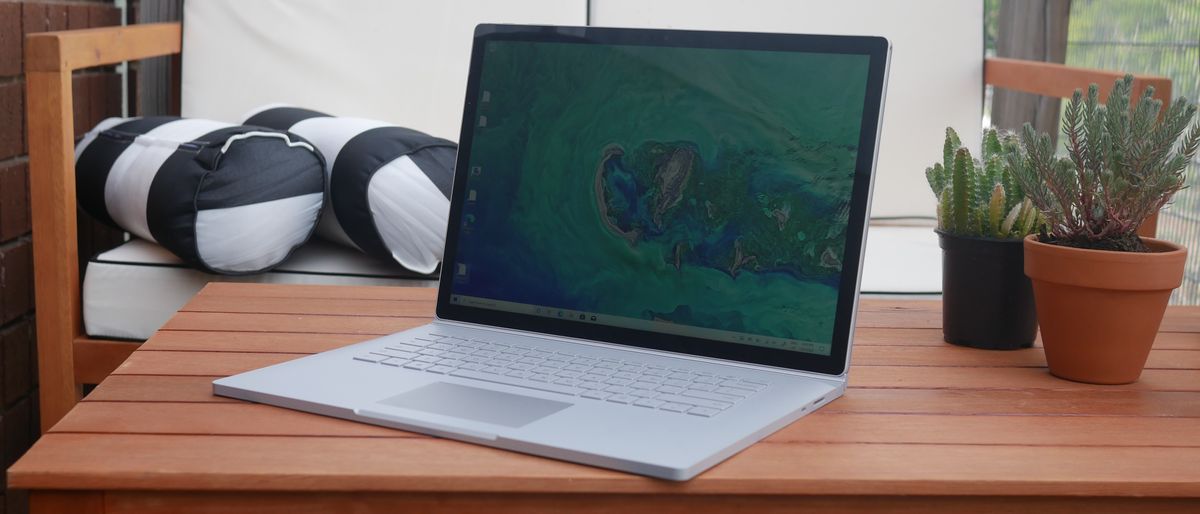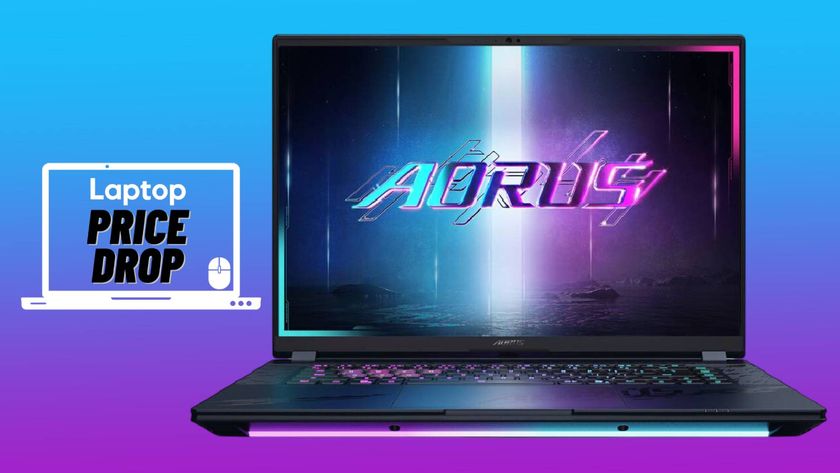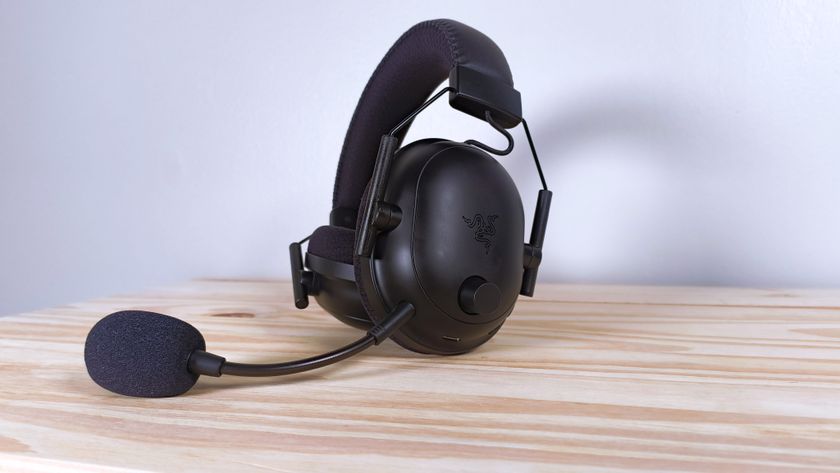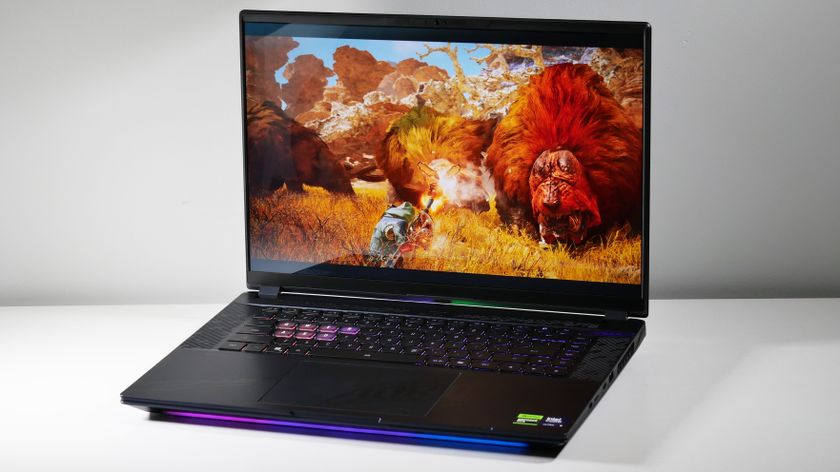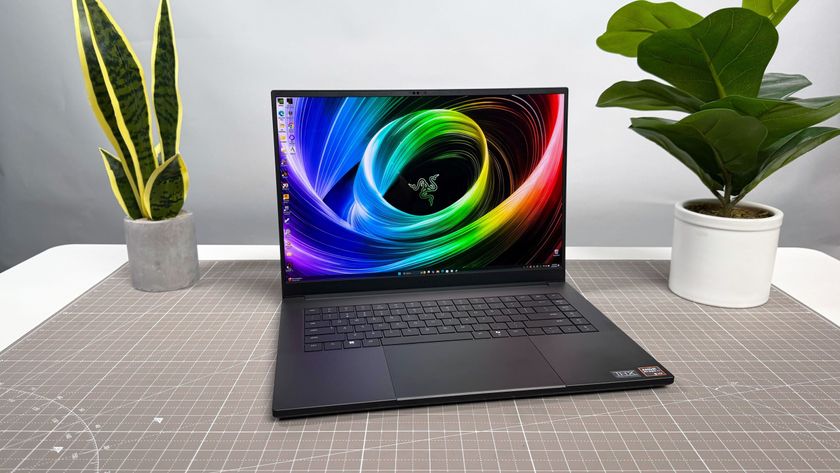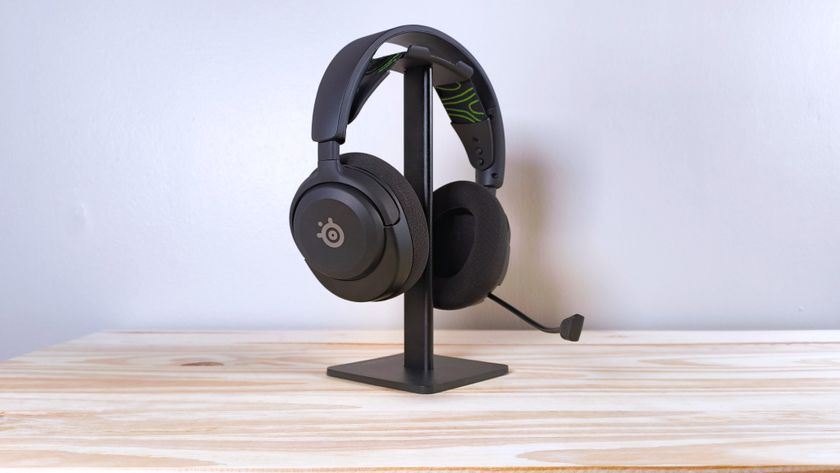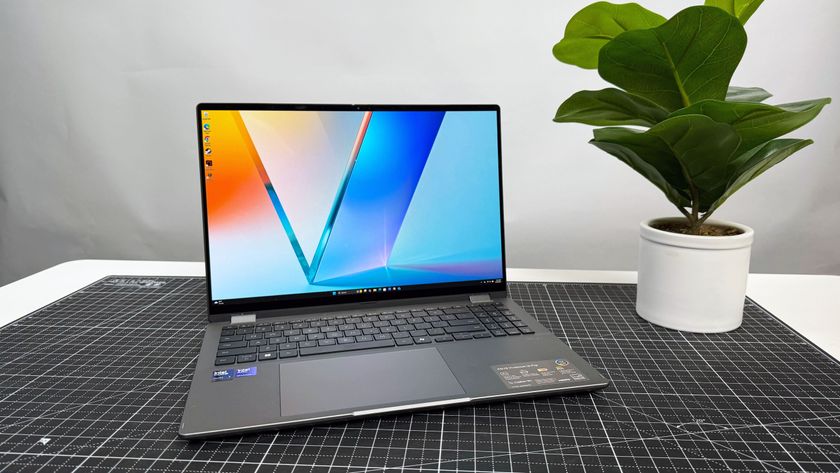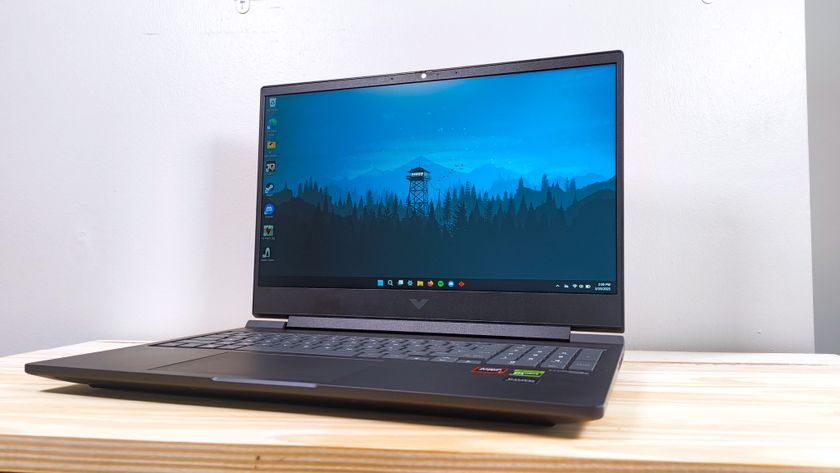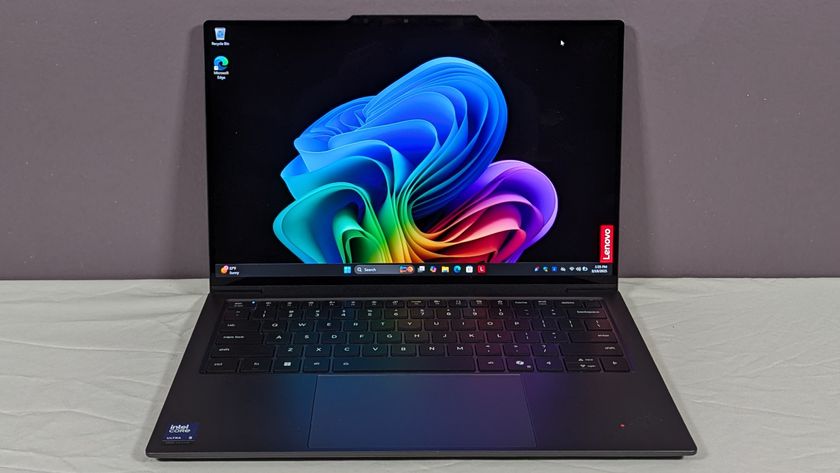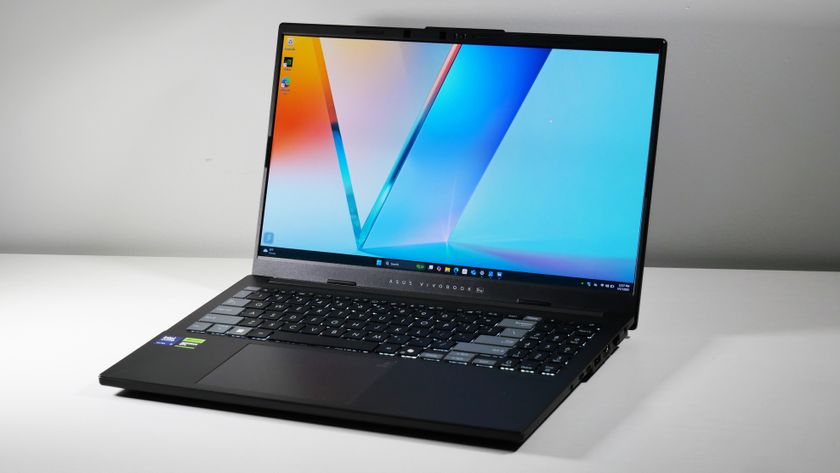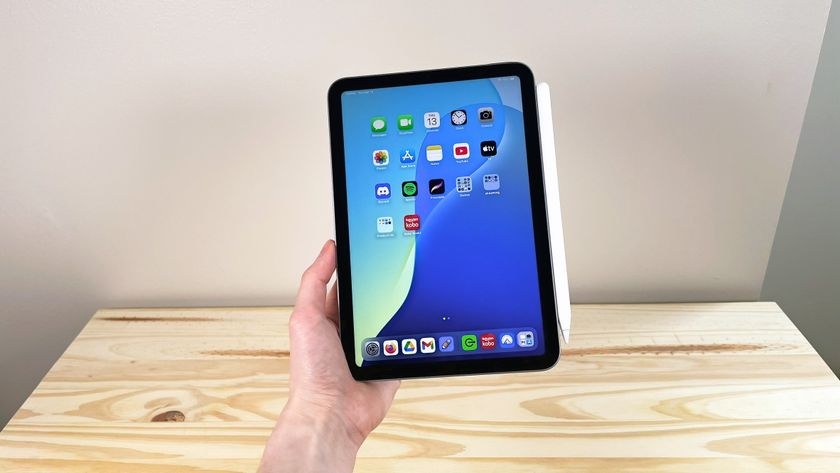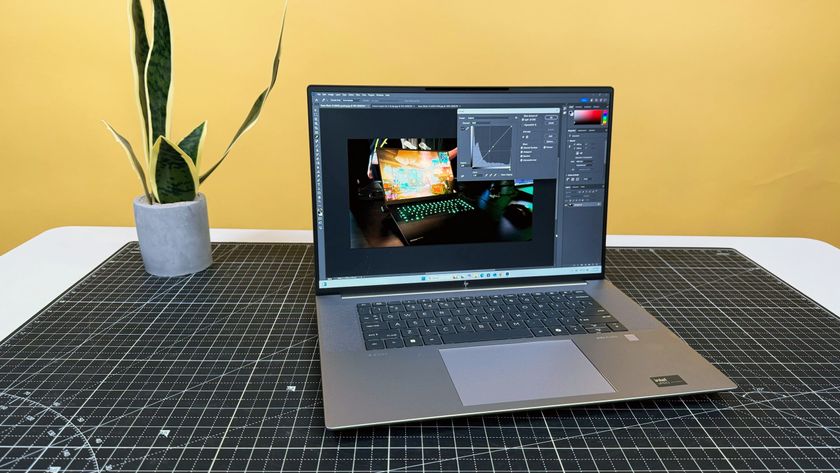Laptop Mag Verdict
Microsoft's Surface Book 3 isn't much of an upgrade but it remains the best solution for those who need a tablet and laptop in one device.
Pros
- +
High-res display gets very bright
- +
Attractive looks and premium feel
- +
Comfortable keyboard
- +
Long battery life (in laptop mode)
- +
Reliable IR camera
Cons
- -
Thick and heavy
- -
Middling performance for its class
- -
No Thunderbolt 3 and only one USB-C
- -
Expensive
Why you can trust Laptop Mag
Price: $2,799
CPU: Intel Core i7-1065G7
GPU: Nvidia GeForce GTX 1660 Ti
RAM: 32GB
Storage: 512GB
Display: 15-inch, 3240 x 2160-pixel
Battery: 11:10 (laptop); 3:27 (tablet)
Size: 13.5 x 9.9 x 0.90 inches
Weight: 4.2 pounds
I've always wanted to own a Surface Book. It has always felt to me like the best version of what so many companies have tried to create: a device that acts as both a laptop and a tablet. Even today, the Surface Book 3 is the only product where you get a full tablet and laptop in a single package. For that reason, the Surface Book 3 ($2,299 starting, reviewed at $2,799) is a compelling device, even though not much has changed in the 2.5 years since the release of the Surface Book 2.
What prevented me from ever buying a Surface Book -- its extremely high price -- remains a problem. The 15-inch Surface Book 3 starts at $2,229 and goes well beyond $3,000 once you've configured it to your liking. On top of that, the unique form factor has its limitations; The Surface Book 3 is thick and heavy and its performance is outclassed by other systems.
But if budget isn't an issue and you want a laptop and tablet in one, then the Surface Book 3 is unrivaled. It's a capable machine with a gorgeous display, premium design and very comfortable keyboard. Battery life is also a bright spot as long as you're in laptop mode. And while it isn't the quickest, the Surface Book 3's discrete Nvidia GPU gives a boost to content creators and gamers. That's enough to land it on our best video editing laptops page.
Microsoft Surface Book 3 price and configuration options
If you're reading this review then you're probably considering buying the Surface Book 3. My advice to you? Start saving now. The Surface Book 3 comes in 13-inch and 15-inch versions, which start at $1,599 and $2,299, respectively.
We were sent the 15-inch model so we'll look at the cost of the larger version. The base model comes with an Intel Core i7-1065G7 CPU, 16GB of RAM, a 256GB SSD and an Nvidia GeForce GTX 1660 Ti Max-Q GPU. Our $2,799 review unit upped the ante with 32GB of RAM and a 512GB SSD. On the high end, there is a $3,399 version with a Core i7 CPU, 32GB of RAM and a 2TB SSD. And if you want to go for broke (literally), you can get a similar config with a 1TB SSD and Nvidia Quadro RTX 3000 GPU with Max-Q for $3,699.
Microsoft Surface Book 3 design
The Surface Book 3 looks like it was cut from a slab of concrete. Matte-gray magnesium coats the chassis and has a subtle texture that feels like paper when you glide your fingers across it.
Microsoft adopted the same mindset as Apple, opting for a simple, unassuming design. To that end, the only notable element on the Surface Book 3 is a reflective Microsoft logo centered on the lid. If you look closely, you'll notice some slight curves on the edges of the deck, and there is a notch on the front edge to help you lift the lid. Otherwise, the deck, keyboard and tablet are all smooth, plain gray surfaces while the touchpad is a silvery shade.
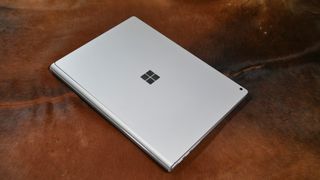
I don't mind the simple appearance. The Surface Book 3 looks classy, feels premium and adheres to the design language seen across Surface products. The Surface Book 3 also does a wonderful job of resisting fingerprints, which is a rare ability for a laptop. I just wish Microsoft had modernized a few things.
Instead, the company failed to make any meaningful changes after 2.5 years between releases. There is still an unsightly gap between the lid and deck when the laptop is closed, and the bezels surrounding the screen are thick. If those frames had been trimmed down a bit, Microsoft could also have reduced the overall size of the machine.
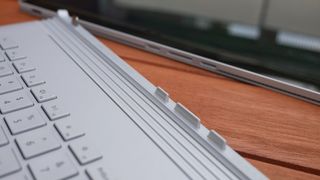
As with the previous models, the standout feature of the Surface Book 3 is the detachable display. With the press of a key, you can detach the 15-inch panel and use it as a discrete tablet. This means that, unlike most laptops, the Surface Book 3's components are housed in the lid, not the bottom portion.
The tablet detaches with a firm yank and reattaches when you line up the connectors and prongs with those on the deck. Removing the tablet is a two-handed operation -- one holds the deck down while the other pulls upward. The display has some heft to it so you'll need to flex those muscles when removing the tablet.
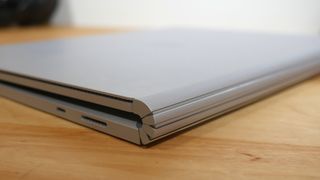
Connecting the tablet and the deck is what Microsoft calls a "dynamic fulcrum hinge." This is the third generation of this laptop and the hinge still leaves an unsightly gap between the lid and the keyboard when the laptop is closed. It's ugly and it leaves the keyboard exposed to debris when you stuff the Surface Book 3 into your bag. Also, the screen wobbles when you tap on the touchscreen, undermining what is an otherwise sturdy laptop.
Another issue with the accordion hinge is that it extends the deck of the laptop. Factor in the thick bezels and the 4.3-pound Surface Book 3 stands at 13.5 x 9.9 x 0.9 inches, which is thicker than the Dell XPS 15 (14.1 x 9.3 x 0.7 inches, 4.2 pounds), the Lenovo Yoga C940 (14 x 9.4 x 0.8 inches, 4.4 pounds), the Apple MacBook Pro (14.1 x 9.7 x 0.6 inches, 4.3 pounds) and the Microsoft Surface Laptop 3 (13.4 x 9.6 x 0.6 inches, 3.4 pounds).
Microsoft Surface Book 3 ports
A single USB-C port isn't good enough on a 15-inch laptop designed for content creators. Worse yet, Microsoft's bizarre security fears mean this isn't even a Thunderbolt 3 input, so I couldn't connect to the 4K Dell monitor I'm reviewing.
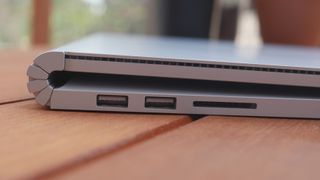
Moving past that disappointment, on the left side of the laptop are two USB 3.1 ports and an SD card slot.
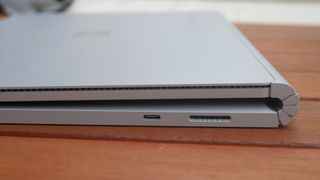
Look on the right side and you'll find the single USB-C port next to a Surface Connect port. There is a second Surface Connect port on the bottom of the tablet and a headphone jack on the top-right corner. It's a little thing, but using wired headphones in laptop mode is awkward because the wire travels from the top edge of the screen.
Microsoft Surface Book 3 display
This is the same 15-inch display used on the Surface Book 2 and it's a good one. The 3240 x 2160-resolution means you get a very sharp image and the 3:2 aspect ratio is great for web browsing or writing reports.
It won't replace going to a theater, but your favorite movies and shows will look vibrant and detailed on the Surface Book 3. In the trailer for Wonder Woman 1984, the superhero's metal armor shimmered a vivacious red, like a sports car with a fresh coat of paint.
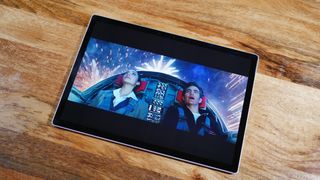
That dense layer of pixels captures such a sharp image that I could see "Casio" written on a watch Gal Gadot gifts to Chris Pine's character. The retro hues throughout the trailer were punchy and the screen was bright enough to distract me from the reflections bouncing off its glossy finish.
I'm surprised our colorimeter only clocked the Surface Book 3's screen at 101% of the sRGB color gamut. Content creators might be disappointed by that color coverage considering the displays on the XPS 15 (115%), the Yoga C940 (105%), the Surface Laptop 3 (105%) and the 16-inch MacBook Pro (114%) are all more vivid. The average for the premium laptop category is 121%.
The Surface Book 3's screen regained some footing when we tested for brightness. It reached an impressive 402 nits, making it more luminous than the panels on the XPS 15 (371 nits), the Surface Laptop 3 (366 nits) and the average premium laptop (368 nits). The screens on the Yoga C940 (432 nits) and MacBook Pro (429 nits) are brighter.
Microsoft Surface Book 3 keyboard and touchpad
The keyboard looks undersized on the Surface Book 3's wide deck, but it's surprisingly comfortable to type on.
The keys are snappy and they deliver a decent amount of travel considering how thin the deck is. There is a nice heftiness to each keystroke, which is rewarded with a satisfying tactile bump. Microsoft could have used the extra space to spread the keys out more, regardless, my fingers never felt cramped as I wrote this review.
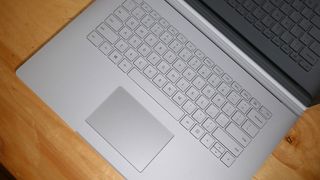
Microsoft chose a transparent font that doesn't contrast well against the silver keycaps. This could be problematic for hunt-and-peck typists who need visual aids. Fortunately, the keys have three levels of backlighting, the highest of which is pretty bright. There isn't a "switch displays" shortcut key on the Surface Book 3 so you'll need to use Windows key + P instead.
I typed at 122 words per minute with a 97% accuracy on the 10FastFingers.com typing test. This is one of my best results, topping my usual 119-wmp with a 5% error rate.
There is so much room on the deck of the Surface Book 3, and yet the 4.1 x 2.7-inch touchpad isn't any bigger than what you'd find on a 13-inch laptop. Case in point: the smallest 13-inch laptop around, the XPS 13, has a 4.4 x 2.6-inch touchpad. I hope Microsoft expands the surface on the next model because, apart from its size, it works really well. The touchpad had no problems tracking my swift swipes or Windows 10 gestures, like pinch-to-zoom or three-finger swipe to change windows.
Microsoft Surface Book 3 tablet mode
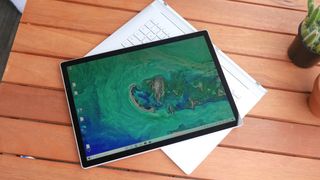
As previously mentioned, you can remove the tablet section of the Surface Book 3 by pressing a key and lifting the screen up. As a tablet, the Surface Book 3 is comically large. I don't mind the size because the magnesium chassis keeps things fairly lightweight. However, Microsoft could have done more. I really wish the lid had a kickstand à la Surface Pro 7. Without it, you either have to hold the massive screen or put it on a flat surface.
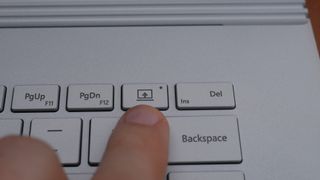
Also, the bottom portion of the Surface Book 3 doesn't connect to the tablet wirelessly, so you have to buy a separate Bluetooth keyboard to avoid using the on-screen keyboard. Yes, you can reconnect the tablet to the base and use it as a laptop, but anyone using the optional $99 Surface Pen stylus in tablet mode will lose keyboard support.
Microsoft Surface Book 3 audio
Because the Surface Book 3 has to function as a full-blown tablet, the speakers are on the lid instead of on the deck. Fortunately, the design restriction doesn't sacrifice audio quality. The dual speakers, located on each side of the screen, produce crisp, balanced sound.
The speakers kept up with the frenetic pacing of Jessie Reyez's debut album "Before Love Came to Kill Us" as it jumped from one genre to the next. Her delicate vocals in ballads like "Love in the Dark" were tender and smooth while the speakers captured her grittiness in explicit tracks like "Dope." In the latter, the heavy bass notes accompanying her rapping weren't thumping on the Surface Book 3, but there was enough weight to give the aggressive track the energy it needed.
Microsoft Surface Book 3 performance
The Surface Book 3 performed well in my testing but the price-to-performance ratio is a problem. That's because the Surface Book 3 relies on Intel Core U-series chips (15W) instead of the beefier 45W H-series processors found in the XPS 15 and MacBook Pro.
For most users, the Surface Book 3's Intel Core i7-1065G7 CPU offers plenty of power, especially when paired with 32GB of RAM. There wasn't a hint of lag after I loaded 25 tabs in the new Edge browser and played four 1080p YouTube videos while streaming a pair of Twitch feeds.
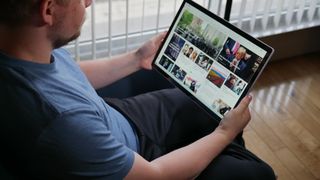
The Surface Book 3 relies on Ice Lake chips so its computing performance can't keep up with laptops that use Comet Lake processors or H-series chips. We proved as much in our benchmarks when the Surface Book 3 notched a 3,831 on the Geekbench 5.0 test. Not only is that short of what the Surface Laptop 3 (4,883), Yoga C940 (5,530), XPS 15 (6,174) and MacBook Pro (7,201) achieved, but it doesn't even hit the average (4,224).
We then tasked the Surface Book 3 to convert a 4K video to 1080p resolution using the Handbrake app. It did so in 21 minutes and 31 seconds, which is far slower than the XPS 15 (10:15), Surface Laptop 3 (17:18), Yoga C940 (11:11) and MacBook Pro (8:00). The average is 18 minutes and 35 seconds.
We've slammed Microsoft in the past for using slow storage drives in its pricey laptops. This time, however, the 512GB PCIe SSD in the Surface Book 3 is its saving grace. The drive duplicated 5GB of multimedia data in 6 seconds for a transfer time of 862.6 megabytes per second. The XPS 15 (726 MBps), Surface Laptop 3 (508.9 MBps), Yoga C940 (463 MBps) couldn't keep the same pace. The premium laptop average is 426.6 MBps.
Microsoft Surface Book 3 graphics
The Surface Book 3, with its Nvidia GeForce GTX 1660 Ti with Max-Q GPU (4GB of vRAM), offers much better performance than the previous GTX 1650 graphics card, even though it doesn't have the RTX chip we were hoping for. For videographers, designers or engineers who need even more oomph, Microsoft now offers a Quadro option with a Quadro RTX 3000 GPU.
The Surface Book 3 proved in our benchmarks that it can play demanding games at high frame rates. The GTX 1660 Ti drove the Sid Meier's Civilization VI: Gathering Storm benchmark (1080p, Very High) at 63 frames per second and hit well above our 30fps threshold when we cranked the resolution up to 4K.
- Best gaming laptops of 2020
It did a good job on the more demanding Shadow of the Tomb Raider test, playing the action-adventure at 55fps on 1080p at the highest graphics settings. In this case, 4K was too much for the Surface Book 3, which hit its ceiling at only 20 fps.
Microsoft's shape-shifting system narrowly topped the XPS 15 (42 fps) on the GTA V test, playing the game at a smooth 55fps on Very High at 1080p.
Microsoft Surface Book 3 battery life
The Surface Book 3 has excellent battery life. The laptop lasted for 11 hours and 10 minutes on our battery test, which involves continuous web surfing over Wi-Fi at 150 nits. It topped the Surface Laptop 3 (9:32), Yoga C940 (8:46) and MacBook Pro (10:55), and only lost out to the XPS 15 (11:53).
Tablet mode is a different story. As a tablet, the Surface Book 3 only gets 3 hours and 27 minutes of battery life. That poor runtime isn't surprising considering the powerful components and high-resolution touchscreen.
Microsoft Surface Book 3 cameras and Windows Hello
If I didn't know better, I'd have guessed the below selfie taken with the Surface Book 3 was actually shot on an external webcam. That's how good the 5-megapixel front-facing camera is. I'd go so far as to say that the Surface Book 3 is one of few laptops I'd use for video conferences on Zoom or Teams without my trusty Logitech C920.

The photo I took of my face was colorful and detailed. I could see strands of hair sticking up, reminding me a haircut is due the moment this pandemic lockdown ends. The lens even caught the flush color in my face from a recent sunburn and the blue/green in my eyes.
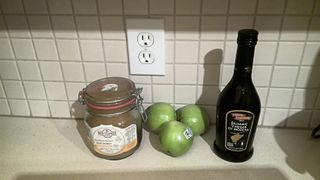
On the back of the tablet is a capable 8MP camera. It takes decent shots but flounders in extreme lighting conditions. This photo I took in my kitchen is sharp -- you can see the writing on the honey and balsamic labels -- but there is a lot of visual noise. A shot I took of white roses on a bright day was blown out.
An IR camera on the top bezel makes logging in a breeze. Setting up facial recognition in Windows Hello saved me the effort of typing a password each time I turned on the laptop. The feature worked instantly and had no problems recognizing me with a hat on or in low-light conditions.
Microsoft Surface Book 3 heat
The bottom portion of the Surface Book 3 stays cool because all of the components are in the tablet section. This works out well because the parts you touch with your fingers -- the touchpad (74 degrees Fahrenheit) and keyboard (76 degrees) -- remained well below our 95-degree comfort threshold. The tablet got warm when we played a 15-minute, 1080p video but even the hottest part, the Microsoft logo on the back, heated to only 91 degrees.
Microsoft Surface Book 3 software and warranty
This is pure Windows 10 Home without pre-installed third-party apps taking up precious storage space. Of the apps that come loaded on Windows 10, the new Edge is the most interesting. Now arriving in an update to all Windows 10 PCs, the browser is very similar to Chrome because it is built on the same engine.
We have guides on how to download Edge, how to import everything from Chrome, and where to download extensions. Other apps installed on the Surface Book 3 include Microsoft's Office suite, Xbox and Windows Security. Your Phone is another standout as it lets you link your phone to view and reply to texts or make and receive calls.
The Surface Book 3 comes with a one-year warranty. See how Microsoft did on our Best and Worst Brands and Tech Support Showdown special reports.
Bottom line
I started this review by admitting the Surface Book used to be my dream laptop. That luster has faded over the years, and Microsoft hasn't done much to give this unique 2-in-1 a new polish. And while it's the only device to offer a genuine laptop and tablet in one package, there are limitations to each of its forms.
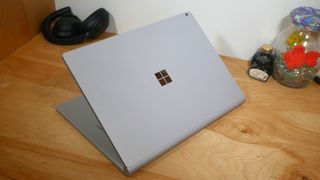
Let's get this out of the way: owning a Surface Book 3 isn't the same as owning a Surface Pro 7 and Surface Laptop 3. As a laptop, the Surface Book 3 is thicker and heavier than the clamshell Surface Laptop 3. And in tablet mode, there is no kickstand for viewing content so you're stuck holding an unwieldy 15-inch screen.
Despite these caveats, some of which are inherent to its daring form factor, the Surface Book 3 is still a device I would love to own. It has a gorgeous display, a premium design, powerful discrete graphics, and an extremely comfortable keyboard. The battery life is also great in laptop mode and the speakers produce surprisingly good audio quality. Sure, other laptops deliver in those same areas, but none of them offer the same utility as the Surface Book 3.
If you don't need a tablet, then you can probably find better options. The XPS 15 is more powerful, smaller and gets even better battery life. The MacBook Pro is another good choice for power users if its exorbitant price isn't a problem. You should also consider the Intel version of the Surface Laptop 3, which gets similar performance to the Surface Book 3 and has an even sleeker design.
Phillip Tracy is the assistant managing editor at Laptop Mag where he reviews laptops, phones and other gadgets while covering the latest industry news. After graduating with a journalism degree from the University of Texas at Austin, Phillip became a tech reporter at the Daily Dot. There, he wrote reviews for a range of gadgets and covered everything from social media trends to cybersecurity. Prior to that, he wrote for RCR Wireless News covering 5G and IoT. When he's not tinkering with devices, you can find Phillip playing video games, reading, traveling or watching soccer.
